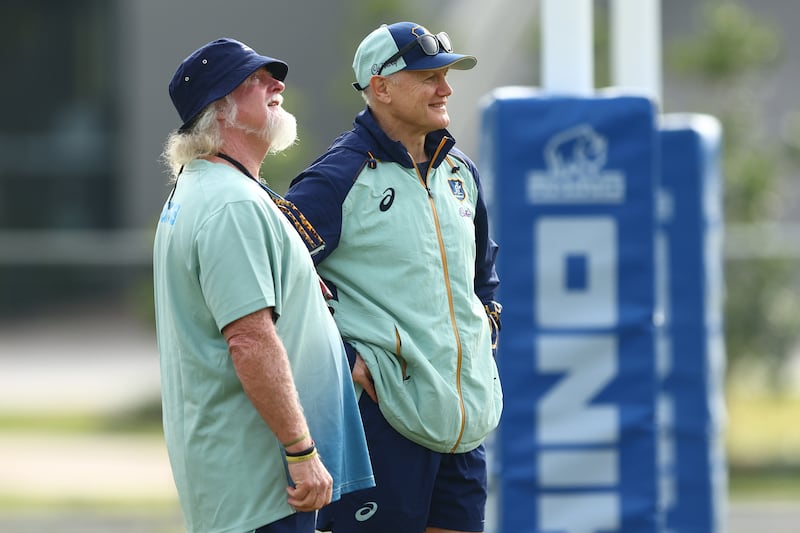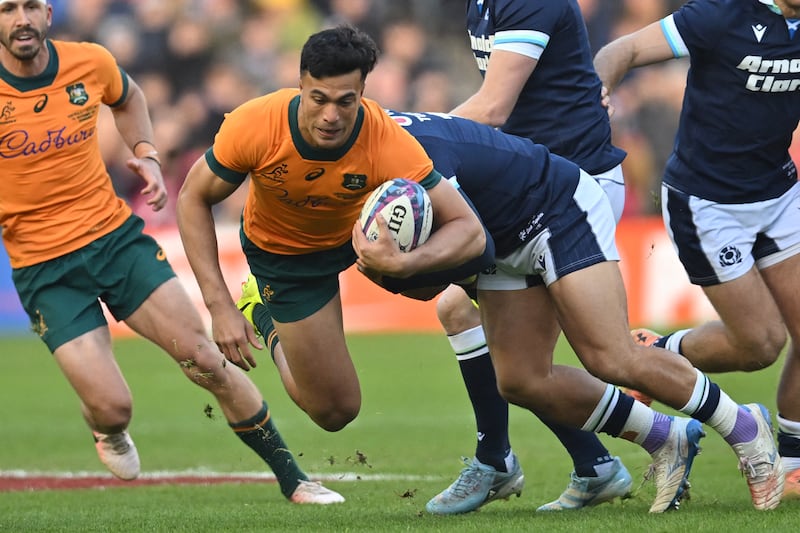If rugby in Australia was getting read its last rites after being bundled out of the group stages of the Rugby World Cup in France under Eddie Jones, Joe Schmidt’s timely arrival as coach has breathed new life into the Wallabies.
After so much negativity for the Wallabies, there is finally some cautious hope.
The decline of rugby union in Australia has been well documented. The game operates in arguably the most competitive sporting market per capita in the world. Rugby is in a constant battle with Australian football, rugby league, soccer and cricket for eyeballs, sponsorships and, most pertinently, the best athletes.
Last month, the Australian Under-18 team beat New Zealand schools for the first time since 2019, an achievement to be savoured. The celebrations were tempered by the fact that one of the Australians’ try-scorers, winger Heamasi Makasini, signed for rugby league side Wests Tigers the following day. The fight to get players to stay committed to rugby starts from a young age.
READ MORE
Australia may have won the World Cup twice, but rugby union sits far lower on the sporting totem pole than most people in Ireland realise. The vast majority of professional players come from New South Wales and Queensland. Rugby league is the primary winter sport of choice now for viewers and participants in these two states, boosted by the game’s annual State of Origin series and its accessibility to fans on free-to-air television.
Alarmingly for rugby, Australian Rules football is also growing rapidly in both of its traditional heartlands. This year’s AFL Grand Final was played between the Sydney Swans and the Brisbane Lions, with the organisation possessing the most sophisticated youth program in the country, ‘Auskick’, driving thousands of Australian boys and girls into trying the sport for the first time.
Rugby in Australia, and specifically the Wallabies, has long been a cheap punchline in bars across Australia, nicknamed ‘the Wobblies’ for their propensity to stumble. Jones was brought in ahead of the World Cup as a ‘Hail Mary’ play and then presided over a disastrous campaign.
Like governing bodies in many nations, Rugby Australia is also dealing with difficult financial circumstances, posting a Aus$9.2 million loss in 2023. In January the Super Rugby side Melbourne Rebels had accumulated a debt of almost Aus$23 million prior to entering voluntary administration in January.
The club was eventually shut down by Rugby Australia and will not play in Super Rugby this year, leaving the game with four professional club sides in the Waratahs, the Reds, the Western Force and the ACT Brumbies.

Schmidt arrived in March to take on one of the most difficult challenges in world rugby. The Wallabies squad were low on morale and the master coach had an extremely short runway to build a competitive squad not only for July’s Rugby Championship, but also to somehow compete with the arrival of the British and Irish Lions in 2025. He had been in semi-retirement in New Zealand contemplating the best fishing spots and arrived into Australia with a huge in-tray to tackle.
From the outset in Australia, Schmidt was the antithesis of the pugnacious Jones. Genial, self-depreciating and gracious with the media, he quickly got the embittered Australian rugby fan base back on side.

Are Ireland back to their best after thrashing Fiji?
In a way, Schmidt benefited from Jones’s brief and brutal tenure; it was so terrible for players and fans that Schmidt could focus simply on generating small wins, such as building a stronger squad. Schmidt did not have the normal pressure that comes with the Wallabies’ head coaching role, given how desperate things had been. The bigger goals of actually competing with the best in world rugby and getting ready for the Lions tour could come later.
Schmidt’s first positive step was building a strong back room team. Ireland’s highly-rated Eoin Toolan was brought in as skills coach and head of analysis, alongside former All Blacks ‘scrum doctor’ Mike Cron and the affable ‘Lord’ Laurie Fisher to lead the defence.
Schmidt also benefited from Rugby Australia’s shrewd recruitment of his friend and former World Rugby colleague Peter Horne as director of high performance. The latter has worked tirelessly behind the scenes to support the new coach.
Finally, in new chief executive and former Wallabies flanker Phil Waugh, Schmidt had a man in the top job who understood the scale of the job that he was undertaking and allowed the coach to immerse himself in the task.

Schmidt’s first action as head coach was to build a far broader talent base that the Wallabies could utilise in advance of the Lions tour and for the home World Cup in 2027. So far in 2024, Schmidt has given 18 players their Wallabies debut, the most for the team since 1920 and 1928. In the Rugby Championship, Schmidt also insisted on picking only Australia-based players for this tournament, to give him a squad of players to shape consistently.
July’s results were tough to digest, defeats against South Africa, New Zealand and a record 67-27 loss in Santa Fe against Argentina. There was a one-point victory against the Pumas in the first Test in La Plata. However, throughout the tournament, there were small green (and gold) shoots that kept Australian rugby believing in a brighter future.
Debutant lock Jeremy Williams quickly established himself as an international quality forward, alongside Perth-born and raised flanker Carlo Tizzano. Tizzano benefited from injuries to incumbent starter Fraser McReight and in his first three games against South Africa (twice) and Argentina he made 57 tackles missing none. There was competition throughout the Wallabies squad that drove players to better performances.
Alongside the debutants, Schmidt also began to unlock the talents of players that had completely lost their confidence under Jones. Fullback Tom Wright was not considered good enough under Jones for the World Cup, but under Schmidt has been transformed into one of the premier attacking backs in the game.
At inside-centre Len Ikitau was also snubbed by Jones and is now one of the first names on the Wallabies team sheet, helped by his bold flick pass to winger Max Jorgensen for the crucial try that beat England in the last minute at Twickenham.

Schmidt also benefited from rugby’s high-profile bet on the 21-year-old Sydney Roosters star Joseph-Aukuso Suaalii. Suaalii is contracted until the World Cup in 2027, with his contract valued at Aus$5.35 million over the next three years.
Suaalii, like so many young stars in the NRL, played rugby in Sydney’s high-level private schools competition, starring for the King’s School in Parramatta. Schmidt’s decision to debut him at 13 against England was bold, given his last game had been as schoolboy at fullback, but it paid off spectacularly.
Suaalii’s aerial ability caused England havoc at restarts and his ability to offload and attract defenders opened up space for his team-mates. There are defensive questions, especially given the demands of the 13 jersey, but so far, he has confounded the critics. He is, however, a doubt to play at the weekend against Ireland, having injured a wrist in the loss to Scotland.
Schmidt’s first return to Ireland as a head coach will be a poignant one, especially given the difficult end to his tenure in 2019.
In Australia, players and fans are desperate for him to extend his tenure beyond the Lions tour until the next World Cup in Australia and he recently said that he will make a decision in December after spending time with his family. Under Schmidt, Ireland prop Andrew Porter admitted that he was so anxious going into camp, he’d count every bump on the driveway going into Carton House.
The Wallabies see their new man very differently. The players are delighted to finally have a coach who has rebuilt their shattered confidence with intricate detail on their roles. He has shaped a squad that is now capable of causing a shock across world rugby.
Schmidt’s time in Ireland left a lasting legacy and he should receive a warm welcome at the Aviva Stadium, given his significant contribution to laying the foundations that helped power the team to the top of the world rankings. He is now in charge of a perennial underdog, typified by the fact that his players can sit in a cafe in Sydney in their full Wallabies tracksuit completely unbothered by the public.
For the first time in a long time, Schmidt has also been able to fly a little more under the radar. In doing so, could be about to complete one of his greatest achievements yet in rugby – making the Wallabies competitive again.














